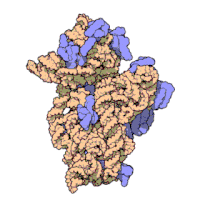
Photo from wikipedia
Herein, a strand displacement amplification (SDA)-assisted CRISPR/Cas12a (LbCpf1) electrochemiluminescence (ECL) biosensor was fabricated for ultrasensitive identification of Staphylococcus aureus (Sa)-16S rDNA. A porphyrinic Zr metal-organic framework (MOF) (PCN-224) nanomaterial was… Click to show full abstract
Herein, a strand displacement amplification (SDA)-assisted CRISPR/Cas12a (LbCpf1) electrochemiluminescence (ECL) biosensor was fabricated for ultrasensitive identification of Staphylococcus aureus (Sa)-16S rDNA. A porphyrinic Zr metal-organic framework (MOF) (PCN-224) nanomaterial was prepared as the coreactant accelerator, which promoted the conversion of S2O82- and SO4*-, thus enhancing the reaction with CdS quantum dots (QDs) and amplifying the ECL emission signal. Meanwhile, with the presence of Sa-16S rDNA, the auxiliary probes and primers stimulated the SDA reaction under the action of Klenow fragment (3'-5' exo-) and Nt. BbvCI specifically recognized Sa-16S rDNA to form a defective T-junction structure and generated second primers to initiate the cycles. Such a structure transformed the input signal (Sa-16S rDNA) into substantial single-stranded DNA products (SP) through SDA. SP acted as activators and activated arbitrary side chain cleavage of CRISPR/Cas12a (trans-cleavage) and further realized effective annihilation of ECL signals. This ECL platform demonstrated desirable assay performance for Sa-16S rDNA with a wide response range of 1 fM to 10 nM, and the limit of detection was 0.437 fM (S/N = 3), showing good sensitivity and specificity. Therefore, the method not only expanded the applications of CRISPR/Cas12a but also opened up a novel strategy for clinical diagnosis.
Journal Title: ACS applied materials & interfaces
Year Published: 2022
Link to full text (if available)
Share on Social Media: Sign Up to like & get
recommendations!